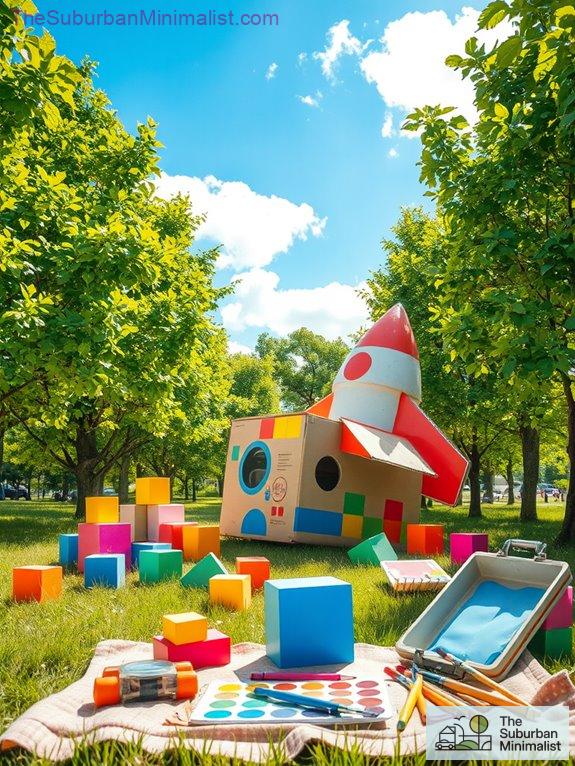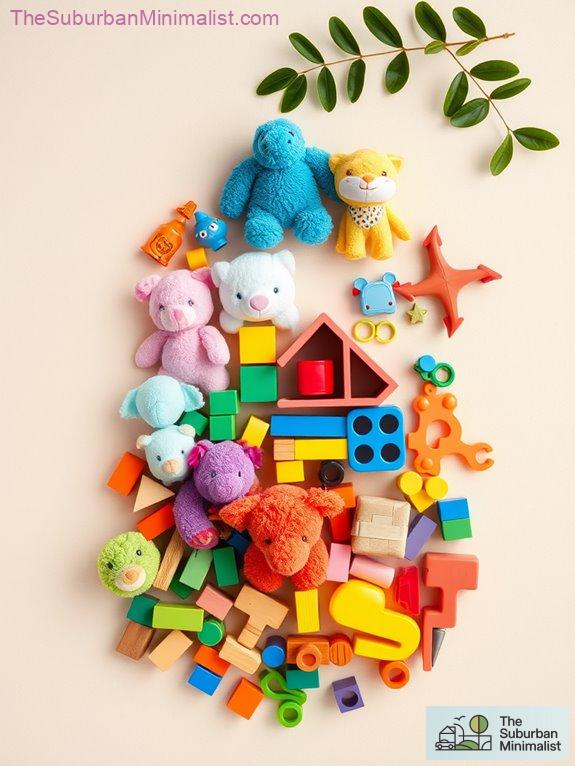When it comes to picking toys for kids, I swear it's not just about the sales—though I do love a good deal.
It's about fueling their imagination and growth.
I remember the time I bought my daughter a set of building blocks. Sure, they were on sale, but watching her create a spaceship out of them made me feel like a proud minimalist mom.
I prioritize toys that promote active play and creativity. Remember, safety is key, so I always choose durable, non-toxic options.
Quality over quantity, right?
Curious how to make your choices matter? Trust me, there's so much more to explore!
Embracing Minimalism: A Toy Story
Once, while decluttering, I stumbled upon a mountain of forgotten toys. I felt a pang of guilt—what would my kids think? But, as I tossed them into the donation box, I realized that less truly is more.
Now, I focus on a few versatile toys that spark creativity and collaboration. This minimalism journey has taught me that it's about experiences, not clutter. Quality toys enrich playtime and help kids develop emotionally and socially. It's a win-win!
Key Takeaways
- Prioritize safety by choosing toys made from non-toxic materials and ensuring no sharp edges to prevent choking hazards.
- Assess the educational value of toys to promote problem-solving, creativity, and cognitive growth in children.
- Select high-quality, durable toys that can withstand daily use, providing long-lasting engagement and peace of mind for parents.
- Encourage open-ended play with fewer, well-chosen toys to stimulate imagination, creativity, and deeper engagement in play activities.
- Involve children in the toy selection process to enhance their decision-making skills and foster communication about their preferences.
Understanding Open-Ended Play

Open-ended play is often the most enriching type of play for kids, allowing them to explore their creativity without the constraints of predetermined rules.
I've seen how types of open-ended play, like building castles with blocks or role-playing adventures, spark a child's imagination. When kids create their own stories, they're not just having fun—they're developing essential skills that benefit creativity and problem-solving. This type of play encourages exploration and experimentation, allowing children to try new ideas in a safe environment. It is important to recognize that material detachment can also enhance a child's ability to embrace open-ended play.
Have you ever watched a child turn a simple box into a spaceship? That's the beauty of open-ended play! It fosters cognitive, social, emotional, and physical development, all while nurturing values like empathy and cooperation.
As I created this website, The Suburban Minimalist, I realized how crucial these experiences are for our little ones.
Let's celebrate the magic of open-ended play together!
Importance of Active Play
While many parents recognize the value of play, active play often stands out as crucial for a child's well-being.
It's incredible how active engagement in play can boost a child's physical development. It strengthens their cardiovascular health, increases flexibility, and helps maintain a healthy weight, all while they're having fun! Active play toys are essential for developing gross motor skills, which further enhances their physical abilities. Additionally, incorporating minimalist principles into toy selection can reduce clutter, allowing children to focus better on their active play experiences.
Have you noticed how kids' moods brighten after a good play session? That's the endorphins at work, enhancing their emotional well-being.
Plus, through playful interactions, they develop social skills that foster teamwork and cooperation.
When I launched The Suburban Minimalist, I aimed to highlight the importance of such safe, active play experiences.
Fostering Imagination in Children

Imagination is an essential part of childhood, and fostering it can lead to endless possibilities for our little ones.
As a parent, I've seen how unstructured playtime sparks creativity. Just think about it—when kids have the freedom to explore with building blocks or art supplies, they immerse themselves in imaginative storytelling without limits. Engaging in problem-solving activities during play helps them develop critical thinking skills that will benefit them throughout their lives. Additionally, embracing minimalistic living can help eliminate distractions, allowing children to focus more on their creative pursuits.
Role-playing games can transform a simple afternoon into an epic adventure, teaching cooperation and empathy along the way.
Encouraging outdoor play also nurtures curiosity. Have you ever noticed how a cardboard box can become a spaceship or a fort?
Educational Value of Toys
Toys hold incredible educational value, making them essential tools for childhood development.
Have you ever noticed how a simple puzzle can captivate a child's attention? That's cognitive growth at work! Educational toys not only enhance memory and focus but also nurture crucial skills. When kids tackle challenges, they develop problem-solving abilities that translate to real-life situations. Engaging with toys also promotes motor skill development, allowing children to refine their movements as they play. Simple games foster social skills as children learn to collaborate and share with others.
I've seen firsthand how toys like wooden blocks promote math skills and hand-eye coordination, all while keeping safety in mind.
It's fascinating to observe children learn through play, boosting their IQ and sensory development without even realizing it.
This is exactly why I created The Suburban Minimalist; I believe in choosing toys that spark joy and foster skill development in a fun, safe environment.
Ensuring Safety and Durability

When selecting toys for kids, ensuring their safety and durability is non-negotiable. I always check the toys' materials and construction quality to keep little ones safe. Wouldn't you feel terrible if a toy broke and caused an injury?
Look for toys that can handle the rough-and-tumble play kids are known for. Avoid anything with sharp edges or small parts that could pose a choking hazard. It's essential to remember that approximately 3 billion toys sold annually in the U.S. reflects the significant consumer demand for safe and engaging toys.
I also make sure the toys comply with safety standards, like ASTM F963. This way, I know they've been tested for harmful chemicals. Trust me, a durable toy not only lasts longer but also brings peace of mind. It's why I created this website, The Suburban Minimalist, to help parents make informed choices.
Selecting Age-Appropriate Toys
Selecting age-appropriate toys is essential for fostering a child's development at every stage.
When I think about toy variety, I realize how important it's to align toys with developmental milestones. For infants, toys should be safe for grasping and rolling, while toddlers benefit from shape sorters and balls. Mindful toy selection can also help families create organized play environments, which are conducive to healthy development.
Preschoolers thrive on creative play, needing construction sets and art supplies. Have you ever noticed how a simple toy can spark a child's imagination? Open-ended toys encourage creativity and imagination, promoting skills without strict rules or limitations.
School-age kids, on the other hand, enjoy more complex toys that challenge their problem-solving skills.
I created this website, The Suburban Minimalist, to help parents navigate these choices, ensuring our little ones play safely while growing joyfully.
Essential Toy Selection Principles

Choosing the right toys involves understanding key principles that guarantee a child's safety, development, and engagement. I always prioritize safety, ensuring toys meet international standards and are free from harmful substances. It's vital to check for sharp edges and potential choking hazards. Additionally, it's important to select toys that are age appropriate to prevent boredom or frustration from mismatched toy complexity. Furthermore, it's beneficial to consider toys that promote active play, as physical activity is essential for children's overall development.
When selecting toys, I focus on quality and durability, picking those that withstand daily use and promote sensory play and creative expression.
Here's a quick comparison to guide your choices:
| Principle | Key Considerations |
|---|---|
| Safety | No sharp edges, non-toxic materials |
| Durability | High-quality, stable materials |
| Educational Value | Promotes problem-solving and creativity |
| Engagement | Versatile and encourages role-playing |
| Child Involvement | Involve them in the selection process |
Ultimately, these principles help create a safe and enriching play environment for our kids.

Leave a Reply